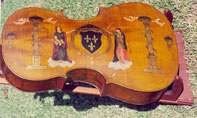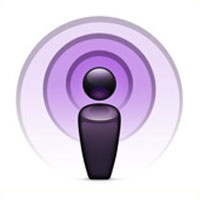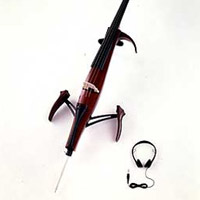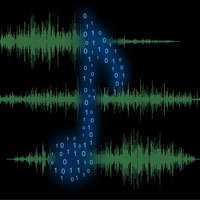- About Us
- Columns
- Letters
- Cartoons
- The Udder Limits
- Archives
- Ezy Reading Archive
- 2024 Cud Archives
- 2023 Cud Archives
- 2022 Cud Archives
- 2021 Cud Archives
- 2020 Cud Archives
- 2015-2019
- 2010-2014
- 2004-2009
 |
“IN THE EVENING” – A Night of Electric Chamber Cello |

In the midst of the Canberra International Chamber Music Festival (28 April – 7 May 2006), Lisa Moore – pianist and founding member of the New York based ‘Bang on a Can All Stars’ raised the controversial questions:
“Is the performer or performance as we know it redundant?”
“Is new technology like pod-cast and web-cast the road to the future?”
“Are digital technologies and performance mutually exclusive?”
These questions, which at first sound like remarkably ‘discordant notes’ to voice at a chamber music festival, were part of a lecture series associated with the festival. Following her lecture on Friday 5 May entitled ‘New directions for music: Developing our performance traditions’, Lisa Moore also performed on the piano that evening, confirming that there remains (for the moment at least) a place for the live performance. After her recital ‘Keys to the Future: the new piano’, she was replaced at the small, stark Canberra Museum and Gallery stage by local cellist Julian Thompson for the final performance of the evening at 10.30pm. The local paper of the Nation’s Capital, The Canberra Times noted that:
“Thompson, who returned to Canberra in 2002 after finishing a Masters of Music at Indiana University on a Fulbright scholarship, said he saw no reason why young people up and about late in Civic [Canberra’s city centre] shouldn’t enjoy the unfamiliar musical experience he planned to offer. They may think they preferred rock or electro, but he might surprise them.”
More than surprise the audience, Thompson provided a wonderfully original fusion of digital technology and classical technique – all fittingly late In the evening – the title of the Zed Zeppelin song made famous (along with Dazed and Confused and In the light)i for Jimmy Page ‘bowing’ his Les Paul electric guitar with a violin bow. (This innovation was apparently the inspiration for Nigel Tufnel playing his Les Paul with a violin in the movie Spinal Tap but it is probably best to avoid focusing on Spinal Tap in a review of creative and developmental music ...)
For almost an hour – in the evening - I stood (as a mere part-time cellist and guitarist), transfixed by the atmospheric performance, which the chamber music festival program had described as:
“A sound odyssey exploring the capabilities of the old and new in his program of works, devised for electric cello.”
Appropriately set against the background of questions about digital technology and the role of the performer, Thompson, his electric cello and the startling sound-scapes that he generated, all provided an emphatic statement that the performance of music (and perhaps classical music in particular) may well flourish in the era of digital technology.
The following night of the chamber music festival showcased the internationally-renowned Japanese cellist Tsuyoshi Tsutsumi, who played Locatelli, Beethoven, Mayuzumi and Britten on a traditional cello, however on this inspiring night, Thompson produced a mixture of “his own compositions, Scottish folk music, guitar music adapted for cello and ambient electro works”,ii all from a skeletal frame of a cello, amplified through an Apple laptop computer. This was the first time I had witnessed the innovation of an electric cello, and judging by the rapturous applause of many (and the early departure of a few!iii) it was evidently the first performance of its kind that many in the audience had experienced. Collectively, we were gathered in a recently designed auditorium, with walls covered in modern art, and dominated by speakers that unleashed unexpected notes from the hybrid offspring of a centuries-old instrument.
 The name cello is an abbreviation of the Italian violoncello, which means "little violone". The violone itself is now obsolete, but was similar to a modern double bass. Cellos were made from as early as the mid-1500’s. The first known maker was Andrea Amati (1505-1577), whose instrument The King survives as the most famous of all cellos – having been decorated with the arms and inscriptions of the French King Charles IX.iv The Amati family became famous over two centuries for its cello making: Amati’s grandson, Nicolo is the best known of the family (both as a craftsman and teacher), and Nicolo’s son Girolamo II, a renowned maker in his own right, was a contemporary of Antonio Stradivari (who although better known for his violins, was apprenticed to a cello maker).
The name cello is an abbreviation of the Italian violoncello, which means "little violone". The violone itself is now obsolete, but was similar to a modern double bass. Cellos were made from as early as the mid-1500’s. The first known maker was Andrea Amati (1505-1577), whose instrument The King survives as the most famous of all cellos – having been decorated with the arms and inscriptions of the French King Charles IX.iv The Amati family became famous over two centuries for its cello making: Amati’s grandson, Nicolo is the best known of the family (both as a craftsman and teacher), and Nicolo’s son Girolamo II, a renowned maker in his own right, was a contemporary of Antonio Stradivari (who although better known for his violins, was apprenticed to a cello maker).
By the 1700’s higher tension, wire-wound strings (fine wire around a thin gut core) had replaced the original gut strings, and the body had been reduced in size from the original Baroque design. The size was not standardised however, until around 1750, by which time Italian players had popularised the instrument in northern Europe also). Within another century (the nineteenth), cellos had become mass-produced rather than hand-made, and by the twentieth century (in time for the 2006 Canberra International Chamber Music Festival) they had been ‘electrified.’
Just as “every generation throws a hero up the pop charts” v, J S Bach’s Six Unaccompanied Suites for Cello, remain the great cello works of the Baroque era (1600 - 1760), Haydn's Cello Concerto #1 in C major is an example of the Classical era of music (1730 -1820), and the cello concertos by Dvořák (B minor) and Elgar (E minor) characterise cello music in the Romantic era (1815 - 1910). Now, in the ‘digital age’, rather than relying on the acoustic resonance of its wooden lineagevi, the electric cello uses electronic amplification to produce sound, typically driven by a piezo pickup system mounted in the bridge of the instrument. As Thompson demonstrated at the chamber music festival, the electric cello has the advantage of utilising such effects as distortion, ‘wah’ and (with the aid of Thompson’s audio software) the ability to record and playback immediately. In much the same way that the cello often plays the bass line in an orchestra (being an octave lower than the viola, or an octave and a fifth lower than violins), Thompson’s pieces often began with a base (bass) melody, and having recorded it, he then layered ‘over the top’ and array of solos and digital effects akin to a DJ at a sound desk.
Perhaps just as staggering as the layered, audio effects that an electric cello allows, the actual notes coming from the four strings of the electric cello are far removed from Amati’s King. Whereas a classical cello is tuned to the pitches A, D, G, and C (A3, D3, G2, and C2 in scientific pitch notation), Thompson (or his Apple Mac, at least) produced a seemingly unlimited range of electronically generated sounds, with all the ‘bells and whistles.’ The standard cello is capable of covering nearly the entire range of pitches produced by the human voice, typically limited by the tuning of the lowest C string (C2 - two octaves below middle C) and the ability of the performer to reach the upper range of the cello (often considered to be C6 - two octaves above middle C, though sometimes higher). Certainly the absence of the wooden body allows an electric cellist to physically reach the higher range far more easily, however in addition, with the briefest of strikes of the accompanying computer keyboard, Thompson seemed to produce pitches far removed from the standard range.
An interesting consequence of the electric cello’s sound production not being based upon the instrument resonating, is the absence of the ‘wolf tone’ (or just ‘wolf’) that plagues conventional cellos and other stringed instruments. The wolf is a noise that is produced when a note played on a stringed instrument matches the natural resonating frequency of the instrument, producing an unwanted loud, harsh tone. Usually wolf tones are only problematic on bowed instruments, since the tones produced are played for much longer periods, and thus are easier to hear (frequently, the wolf is present on or in between the pitch E and F).
For all the innovation and technical advances however, certain constants remained in this engaging performance. The electric cellist’s bow appeared (from a distance at least) to be the traditionally styled woodvii and horsehairviii. (The standard bow tends to be 73 cms in length and comprise up to two hundred horse hairs.ix) When the bow was rested, Thompson’s classical training remained and the modern instrument resonated with the established techniques of ‘Pizzicato’x and strumming of chords as if playing a guitar. Likewise the electric cello maintains the elements of the left hand, such as ‘Harmonics’,xi ‘Vibrato’xii and ‘Glissandi’.xiii
 The technology of the electric cello in the twenty first century may have stripped the cello of its sensual bouts and curves (typically constructed with a spruce top and maple back, sides, and neck) and the distinctive f-curved holes that allow air to ‘breath’ in and out of a stringed instrument. While the modern electric cello appears withered, skeletal and naked by comparison, and seems so brutally minimalist with its often harsh, industrial-looking design, it allows a depth of sound - far deeper and ‘clothed’ than its predecessor. It may not have become the mainstay of modern music as the electric guitar has (and increasingly, even the electric violin) yet non-traditional cello groups such as Apocalyptica xiv(a group of Finnish cellists best known for their versions of Metallica), and Rasputina xv (a group of three female cellists who have accompanied Marilyn Manson, Porno for Pyros and Cheap Trick among others) have enjoyed popular exposure. Ever since the 1960’s when the Beatles included a cello part in Eleanor Rigby and Michelle, the list of popular musicians who have done likewise has grown to include groups such as: Nirvana, Powderfinger, Ben Folds, Gorillaz, Echo & the Bunnymen, Gomez, PJ Harvey, INXS, Smashing Pumpkins, the Moody Blues, Evanescence, Paul Weller, Green Day and Travis.xvi
The technology of the electric cello in the twenty first century may have stripped the cello of its sensual bouts and curves (typically constructed with a spruce top and maple back, sides, and neck) and the distinctive f-curved holes that allow air to ‘breath’ in and out of a stringed instrument. While the modern electric cello appears withered, skeletal and naked by comparison, and seems so brutally minimalist with its often harsh, industrial-looking design, it allows a depth of sound - far deeper and ‘clothed’ than its predecessor. It may not have become the mainstay of modern music as the electric guitar has (and increasingly, even the electric violin) yet non-traditional cello groups such as Apocalyptica xiv(a group of Finnish cellists best known for their versions of Metallica), and Rasputina xv (a group of three female cellists who have accompanied Marilyn Manson, Porno for Pyros and Cheap Trick among others) have enjoyed popular exposure. Ever since the 1960’s when the Beatles included a cello part in Eleanor Rigby and Michelle, the list of popular musicians who have done likewise has grown to include groups such as: Nirvana, Powderfinger, Ben Folds, Gorillaz, Echo & the Bunnymen, Gomez, PJ Harvey, INXS, Smashing Pumpkins, the Moody Blues, Evanescence, Paul Weller, Green Day and Travis.xvi
An unexpected twist in this review of one aspect of music’s technological advance, is the fact that when I approached Thompson about his music after his performance, we was without website or CDs to allow pod-casting or web-casting of the future. With only a little knowledge of music, but a great appreciation of an electrifying cello performance on a cold Canberra night, I can only hope that technology brings Julian Thompson and the electric cello to a wider audience.
So, when considering the issues of Moore’s ‘New directions in music’ in opening:
- this performer and his performance are not redundant; and
- the new technologies of pod-cast and web-cast may be the road to the future.
But in both cases it is because a classically trained performer harnessed digital technologies and braved a new ‘electric world’ for the most sensual and mellifluous member of the music world – ‘Amati’s King’ – the cello.
Additional information:
Wikipedia, the Free Encyclopedia (http://en.wikipedia.org/wiki/Cello )
History of the cello instrument (http://caca.essortment.com/celloinstrument_rfau.htm)
Cello Heaven (www.celloheaven.com )
iEddie Phillips, of the band ‘Creation’, produced by Shel Talmy (who also produced for Jimmy Page), was the first guitarist credited with the use of a violin bow.
Source: http://en.wikipedia.org/wiki/Cello
ii Again, from The Canberra Times review of 5 May 2006.
iiiPerhaps confirming the sentiments in The Canberra Times article that: “… more conventional classical music lovers … might be astonished by his electric cello and the sounds he would produce on it.”
iv It was exhibited in 1968 at the Rockefeller University for the Conference on Scientific Aspects of Musical Instruments with the following information: "Violoncello by Andrea Amati, Cremona, not after 1574, body length 75.5 cm (reduced from larger dimensions). Neck and fittings modern. Painted and gilded with the arms, devices, and mottoes of Charles IX, King of France. Label probably a facsimile, dated 1572."
(Source: http://www.celloheaven.com/masters/king.htm)
v Entirely unrelated Paul Simon lyric from the song Boy in the Bubble.
viSound is produced from the air mass inside the instrument. Internally, the cello has two important features: the bass bar and the sound post (also called a sound peg), which are responsible for transferring the strings' vibrations to the body of the instrument, which in turn transfers them to the air mass inside the instrument
(Source: http://en.wikipedia.org/wiki/Cello)
vii Better quality bows are traditionally made from Pernambuco (a heavy, resinous wood with great elasticity and high sound velocity which makes it an ideal wood for instrument bows), while lesser quality bows may be brazilwood. Both woods come from the same species of tree (Caesalpina echinata), but Pernambuco is the heartwood of the tree and is much darker (Brazilwood is stained/painted dark to compensate).
(Source: http://en.wikipedia.org/wiki/Cello )
viii The horsehair may often be replaced by synthetic hair, while the wooden bow may be replaced by fiberglass or carbon fibre (or wood with a carbon fibre core).
(Source: http://en.wikipedia.org/wiki/Cello)
xPizzicato is where the string is plucked with the right hand fingers, or very rarely those of the left hand, and the bow is simply held away from the strings by the rest of the hand or even set down. A single string can be played pizzicato, or double, triple, or quadruple stops can be played. Occasionally, a player must bow one string with the right hand and simultaneously pluck another with the left.
xi Harmonics are produced by lightly touching, but not fully depressing, the string with the finger at certain places, and then bowing (or even plucking) the string. For example, the halfway point of the string will produce a harmonic that is one octave above the unfingered (open) string (in effect doubling the frequency of the open string).
xii Vibrato consists of oscillating the finger of the left hand up and down while playing a note. As a result, the pitch of the note will waver slightly, and a well developed vibrato technique is a key expressive device. In the Romantic period, vibrato was used on almost every note, while in other styles, such as Baroque pieces, vibrato is used only very rarely, as an ornament. Typically, the lower the pitch of the note played, the wider the vibrato used.
xiiiGlissandi is the playing of notes by sliding the finger up or down the fingerboard without releasing the string. This causes the pitch to rise and fall smoothly, without separate, discernable steps, as is produced by a slide guitarist.
